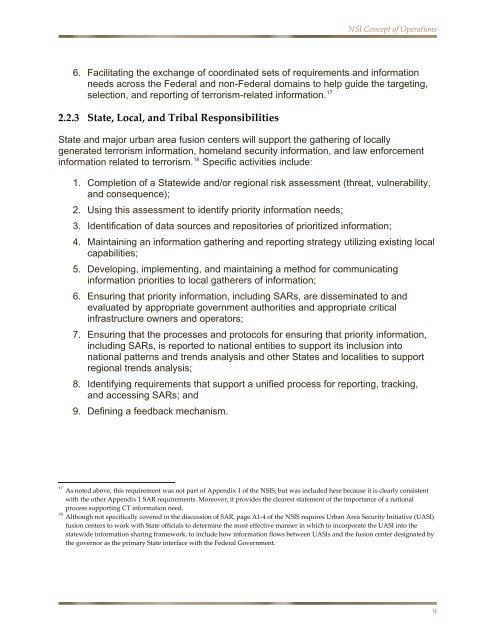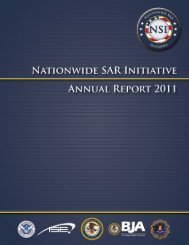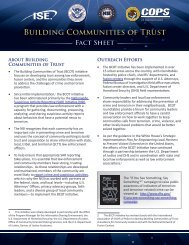NSI Concept of Operations Version 1, December 2008
NSI Concept of Operations Version 1, December 2008
NSI Concept of Operations Version 1, December 2008
You also want an ePaper? Increase the reach of your titles
YUMPU automatically turns print PDFs into web optimized ePapers that Google loves.
<strong>NSI</strong> <strong>Concept</strong> <strong>of</strong> <strong>Operations</strong><br />
6. Facilitating the exchange <strong>of</strong> coordinated sets <strong>of</strong> requirements and information<br />
needs across the Federal and non-Federal domains to help guide the targeting,<br />
selection, and reporting <strong>of</strong> terrorism-related information. 17<br />
2.2.3 State, Local, and Tribal Responsibilities<br />
State and major urban area fusion centers will support the gathering <strong>of</strong> locally<br />
generated terrorism information, homeland security information, and law enforcement<br />
information related to terrorism. 18 Specific activities include:<br />
1. Completion <strong>of</strong> a Statewide and/or regional risk assessment (threat, vulnerability,<br />
and consequence);<br />
2. Using this assessment to identify priority information needs;<br />
3. Identification <strong>of</strong> data sources and repositories <strong>of</strong> prioritized information;<br />
4. Maintaining an information gathering and reporting strategy utilizing existing local<br />
capabilities;<br />
5. Developing, implementing, and maintaining a method for communicating<br />
information priorities to local gatherers <strong>of</strong> information;<br />
6. Ensuring that priority information, including SARs, are disseminated to and<br />
evaluated by appropriate government authorities and appropriate critical<br />
infrastructure owners and operators;<br />
7. Ensuring that the processes and protocols for ensuring that priority information,<br />
including SARs, is reported to national entities to support its inclusion into<br />
national patterns and trends analysis and other States and localities to support<br />
regional trends analysis;<br />
8. Identifying requirements that support a unified process for reporting, tracking,<br />
and accessing SARs; and<br />
9. Defining a feedback mechanism.<br />
17<br />
As noted above, this requirement was not part <strong>of</strong> Appendix 1 <strong>of</strong> the <strong>NSI</strong>S, but was included here because it is clearly consistent<br />
with the other Appendix 1 SAR requirements. Moreover, it provides the clearest statement <strong>of</strong> the importance <strong>of</strong> a national<br />
process supporting CT information need.<br />
18<br />
Although not specifically covered in the discussion <strong>of</strong> SAR, page A1‐4 <strong>of</strong> the <strong>NSI</strong>S requires Urban Area Security Initiative (UASI)<br />
fusion centers to work with State <strong>of</strong>ficials to determine the most effective manner in which to incorporate the UASI into the<br />
statewide information sharing framework, to include how information flows between UASIs and the fusion center designated by<br />
the governor as the primary State interface with the Federal Government.<br />
9






